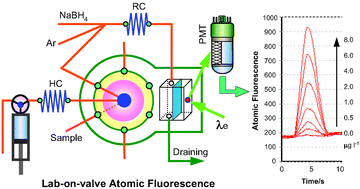The development of a miniature atomic fluorescence spectrometric system in a lab-on-valve for mercury determination
Abstract
A miniaturized atomic fluorescence spectrometric system was developed based on a novel lab-on-valve (LOV) configuration. The LOV integrates a micro-scale vapour generation chamber with a PTFE membrane (pore size 0.45 μm, thickness 60 μm) as the gas–liquid separation medium. The mercury cold vapour generated by reaction of sample with tetrahydroborate was separated and immediately excited in the outlet of the membrane gas–liquid separator by 253.7 nm incident light from a mercury hollow cathode lamp, while the fluorescence was monitored using a side-on photomultiplier. Both the incident light and the fluorescence were transmitted by fibre optics (600 or 1000 μm in diameter). A few important parameters governing the performance of the LOV atomic fluorescence spectrometric system were investigated, encompassing the positioning of the fibre optic tips in the excitation chamber, the concentration and volume of NaBH4 solution, as well as the effect of the concomitant hydrogen from the reduction reaction of mercury. The limit of detection of the system for mercury was estimated to be 0.1 and 0.02 μg l−1 by using fibre optics of 600 and 1000 μm diameter, respectively, with volume consumptions of 500 μl and 400 μl for sample and NaBH4 solutions. A sampling frequency of 90 h−1 was achieved along with


 Please wait while we load your content...
Please wait while we load your content...